Acadia National Park, located on the rugged coastline of Maine, is an ideal destination for bird-watching enthusiasts. With a diverse range of habitats, from rocky shorelines to forested mountaintops, the park offers an array of habitats for over 330 species of birds.
Some of the most popular birds of Acadia National Park include the Peregrine Falcon, Bald Eagle, and Common Loon. Birders can also observe warblers, thrushes, vireos, and other songbirds during the spring and summer months.
No matter what time of year you visit, Acadia National Park offers a unique opportunity to observe a rich variety of birds in their natural habitats.
1. Ruffed Grouse

The Ruffed Grouse is a medium-sized bird native to forests from the Appalachian Mountains across Canada to Alaska.
It has an impressive range and is widely distributed throughout North America, making it one of the most abundant game birds in the region.
Unlike many other grouse species, this bird does not migrate and remains in its chosen habitat year round. The Ruffed Grouse has unique features that set it apart from similar birds.
Its feathers are ruffled like fur giving it a soft look; and its tail can be spread out into an umbrella shape when threatened or startled by predators.
This beautiful creature makes for great hunting opportunities with plenty of success stories among seasoned hunters – but only if they know what they’re doing.Scientific classification:
| Kingdom | Animalia |
| Phylum | Chordata |
| Class | Aves |
| Order | Galliformes |
| Family | Phasianidae |
| Tribe | Tetraonini |
| Genus | Bonasa Stephens, 1819 |
| Species | B. umbellus |
Also Featured In: Most Common United States Birds, Common Birds in Saskatchewan
2. Belted Kingfisher

The belted kingfisher is a large, eye-catching bird native to North America. It belongs to the family Alcedinidae and has been divided into three subfamilies by recent research.
The species was first described in 1758 by Carl Linnaeus in his Systema Naturae.
This water Kingfisher stands out for its size as well as its striking plumage; males are bright blue on top with white below and females have rusty brown backs and wings with a thick black breast band across their chest.
They also possess an impressive call which can be heard from quite far away.
Belted kingfishers feed mainly on small fish but will sometimes also eat crustaceans, insects or even amphibians if they come across them while hunting around rivers or streams.
All in all, this is truly one remarkable bird that deserves our admiration.Scientific classification:
| Kingdom | Animalia |
| Phylum | Chordata |
| Class | Aves |
| Order | Coraciiformes |
| Family | Alcedinidae |
| Subfamily | Cerylinae |
| Genus | Megaceryle |
| Species | M. alcyon |
Also Featured In: Most Popular Bird Species in North America, Birds That Live in Colorado
3. Yellow-Rumped Warbler

The Yellow-rumped Warbler (Setophaga coronata) is a migratory bird species that can be found throughout North America.
It has an extensive range, from the Pacific and Atlantic coats of the US to Canada and Central America, with a concentration in northern areas during breeding season.
These birds migrate southwards for wintering grounds where they find plentiful food sources such as insects and berries.
They are easily identified by their yellow patches on either side of their tails, along with white underparts, gray back feathers and two distinct crown stripes.
One black or greyish-brown above the eyes extending towards its neck banded in yellow or light brown colouration.
Furthermore, these warblers have strong legs which allow them to cling onto branches while hunting for prey making them adept at maneuvering through tree cover quickly.
All together this makes the Yellow-rumped Warbler an attractive backyard visitor year round.Scientific classification:
| Kingdom | Animalia |
| Phylum | Chordata |
| Class | Aves |
| Order | Passeriformes |
| Family | Parulidae |
| Genus | Setophaga |
| Species | S. coronata |
Also Featured In: Birds Live Near San Diego, Common Birds That Live in Las Vegas
4. American Black Duck
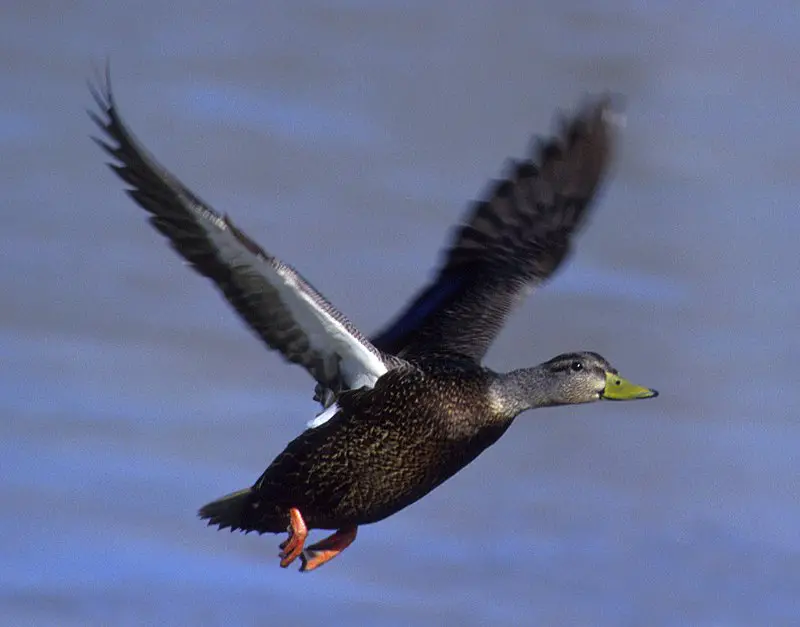
The American black duck is a large dabbling bird found in the Anatidae family. It has a dark brown plumage and measures between 21 to 23 inches in length, with an average wingspan of 35-37 inches.
This species can weigh anywhere from 1.59 – 3.62 lbs on average and are known as one of the heaviest ducks within their genus Anas.
They have similarities to female mallards but are generally darker overall which helps them stand out among other water fowls.
The American Black Duck mainly inhabits wetlands, marshes, lakes, rivers and estuaries across North America making it well suited for its aquatic lifestyle.Scientific classification:
| Kingdom | Animalia |
| Phylum | Chordata |
| Class | Aves |
| Order | Anseriformes |
| Family | Anatidae |
| Genus | Anas |
| Species | A. rubripes |
Also Featured In: Birds that can be Seen in Outer Banks, Birds of Nova Scotia
5. Black Guillemot

The Black Guillemot is a striking seabird found throughout the northern Atlantic coasts and eastern North American coasts. It has black feathers with white underparts, a red bill, and bright yellow feet.
They live around rocky shores, cliffs, and islands in single or small groups.
During winter months they migrate southwards from their high arctic breeding grounds to search for food sources such as fish eggs or invertebrates like shrimp that can be caught near shorelines.
Their diet also includes seeds and berries during summertime when they are nesting on coastal ledges creating burrows where they lay up to four pastel-colored eggs at once.
These amazing birds are very efficient swimmers using both their wings and webbed feet to propel themselves through water quickly while hunting prey.Scientific classification:
| Kingdom | Animalia |
| Phylum | Chordata |
| Class | Aves |
| Order | Charadriiformes |
| Family | Alcidae |
| Genus | Cepphus |
| Species | C. grylle |
Also Featured In: Birds of United Kingdom, Birds You’ll Find in the Sea
6. Common Goldeneye
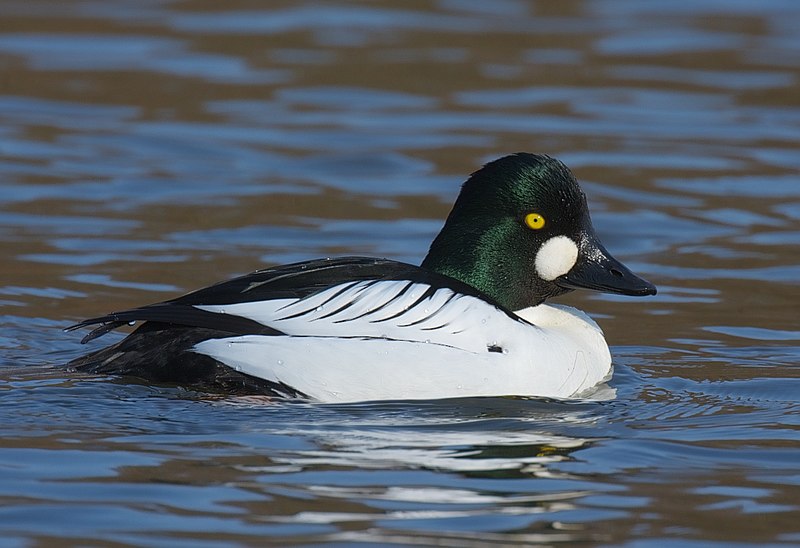
The Common Goldeneye is a medium-sized sea duck from the genus Bucephala. It has an iconic golden eye and bulbous head, which gave it its scientific name – Boukephalos (bullheaded).
This species can be found in many areas of North America, Europe and Asia. They are usually seen swimming alone or in pairs near large bodies of open water such as lakes and rivers.
In addition to their distinctive eyes, they have white wing patches on either side with black spots along the edges – helping them stand out among other ducks.
The diet of these birds includes aquatic insects, mollusks and crustaceans.
During mating season males often perform elaborate courtship displays including head bobbing while producing loud calls that can travel quite far distances across the landscape.Scientific classification:
| Kingdom | Animalia |
| Phylum | Chordata |
| Class | Aves |
| Order | Anseriformes |
| Family | Anatidae |
| Genus | Bucephala |
| Species | B. clangula |
Also Featured In: Birds of Poland, Black And White Birds You Don’t Know About
7. Loons
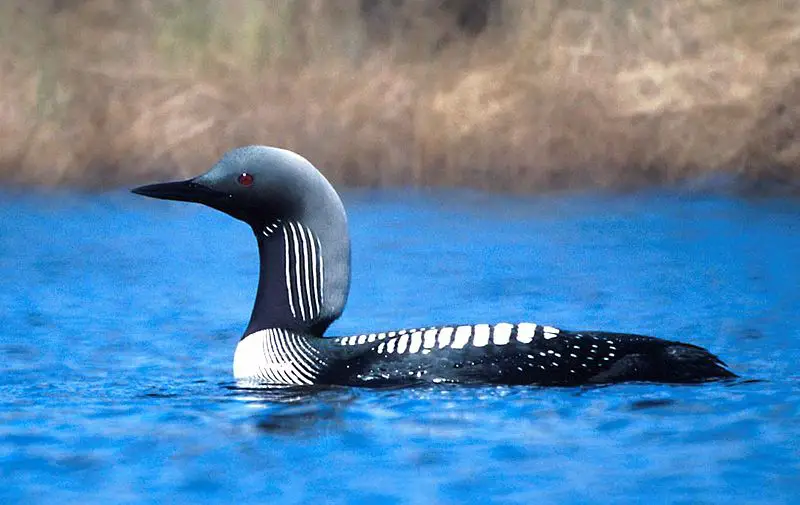
Loons are an aquatic bird found in both North America and northern Eurasia. They can be identified by their size, which is similar to that of large ducks or small geese.
When swimming, loons resemble these birds in shape as well as movement.
Unlike other waterfowl however, they have pointed bills with serrated edges and feet set far back on their bodies; this makes them excellent swimmers but hinders the ability to walk on land properly.
Loons feed mainly on fish but also eat insects and crustaceans when available.
In addition to being a common sight around lakes during warmer months, many species migrate south for winter where they live near coastal waters until returning again in springtime.Scientific classification:
| Kingdom | Animalia |
| Phylum | Chordata |
| Class | Aves |
| Order | Gaviiformes |
| Family | Gaviidae Coues, 1903[1] |
| Genus | Gavia Forster, 1788 |
Also Featured In: Common Birds in Canada, Flocks Birds around Us
8. Red-Breasted Nuthatch

The Red-breasted Nuthatch is a beautiful and vocal songbird that can be found in coniferous forests across Canada, Alaska, the northeastern United States and western US.
This small bird has blue-grey upperparts with cinnamon underparts, a white throat and face with black eye stripe, straight grey bill and black crown.
Its call sounds like a tin trumpet; it’s high-pitched yet nasal.
During mating season they form monogamous pairs to build their nest near tree trunks or branches at low heights off the ground where they lay 2 – 8 eggs at once.
They are very active little birds who love clinging to trees while searching for insect larvae or seeds within the bark of trees which helps control pest populations.Scientific classification:
| Kingdom | Animalia |
| Phylum | Chordata |
| Class | Aves |
| Order | Passeriformes |
| Family | Sittidae |
| Genus | Sitta |
| Species | S. canadensis |
Also Featured In: Blue Birds You’ll Found around Us, Birds Commonly Found in New York
9. White-Throated Sparrow

The White-throated Sparrow is a small passerine bird of the New World sparrow family Passerellidae.
It has distinctive yellow and black stripes on its head, white throat and chest with grey back and wings, along with light brown legs.
The scientific name “Zonotrichia albicollis” comes from Ancient Greek for ‘band’ (ζώνη) referring to its distinctive striped crown, and Latin for ‘white neck’ (albus collum).
These birds are usually found in wooded areas such as coniferous forests or deciduous habitats in North America where they feed mainly on insects during summer months; transitioning to seeds during winter.
They build their nests near ground level using grasses, twigs or moss lined with feathers.
White-throated Sparrows may be solitary but also form flocks when migrating southward each fall season which typically occurs over mid-late October through November depending on location within range.Scientific classification:
| Kingdom | Animalia |
| Phylum | Chordata |
| Class | Aves |
| Order | Passeriformes |
| Family | Passerellidae |
| Genus | Zonotrichia |
| Species | Z. albicollis |
Also Featured In: Birds Live in Arkansas, Birds that Migrate through Illinois in the Spring
10. Horned Grebe

The Horned Grebe is a small aquatic bird that belongs to the family of Podicipedidae. It has two known subspecies: P. auritus, which breeds in Palearctic regions, and P. cornutus which breeds in North America.
The Eurasian subspecies inhabits most parts of northern Europe and the Palearctic from Greenland to western China while its American counterpart can be found across Canada and Alaska down through California and some areas of Mexico’s coasts too.
This species adapts easily to different wetland habitats like lakes, rivers or marshes with abundant vegetation cover for nesting purposes as well as providing protection against predators.
They are excellent divers who feed on fish eggs, insects, mollusks & crustaceans along with plant material such as seeds & grains when available seasonally throughout their range.Scientific classification:
| Kingdom | Animalia |
| Phylum | Chordata |
| Class | Aves |
| Order | Podicipediformes |
| Family | Podicipedidae |
| Genus | Podiceps |
| Species | P. auritus |
Also Featured In: Native Birds Of Libya, Common Estonian Birds
11. Purple Finch
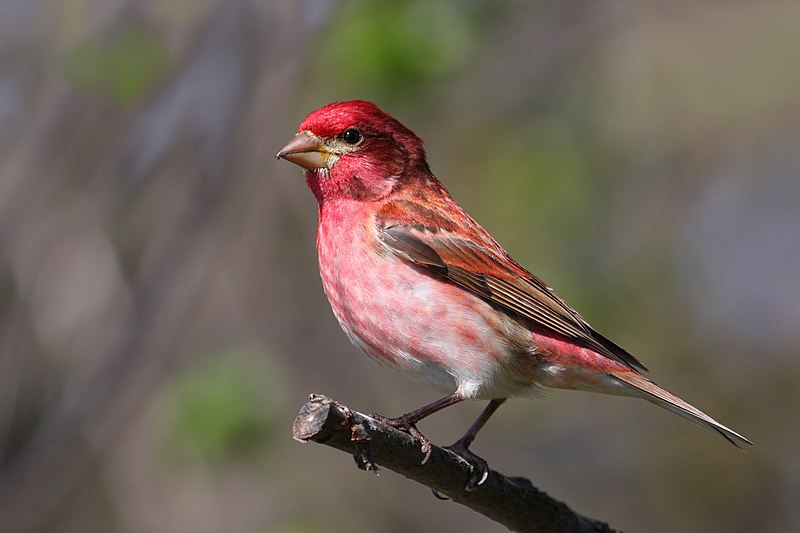
The Purple Finch is a species of finch from North America, belonging to the Fringillidae family.
It’s also known as an “American Rosefinch” due to its resemblance in color and size to some European rosefinches.
Their plumage ranges from pinkish-purple on their heads and wings, with a light brown underside.
They are small birds that measure about 5-6 inches long with short thin beaks for eating seeds and insects.
In addition, they have thick round bodies which help them stay warm during cold winters in the northern parts of their range.
The Purple Finch has adapted well over time making it easier for them to survive even though there are increasing threats posed by humans such as deforestation or habitat destruction caused by development projects near their habitats.Scientific classification:
| Kingdom | Animalia |
| Phylum | Chordata |
| Class | Aves |
| Order | Passeriformes |
| Family | Fringillidae |
| Subfamily | Carduelinae |
| Genus | Haemorhous |
| Species | H. purpureus |
Also Featured In: Georgia Birds, Magenta Birds You Didn’t Know
12. Great Black-Backed Gull

The Great Black-Backed Gull is the largest member of its family and aptly named as “king of the Atlantic waterfront”.
It can be found on both European and North American coasts, islands in the North Atlantic, or farther inland near large lakes.
This seabird is an aggressive hunter with a tendency to scavenge for food that it may not have caught itself.
In addition to their formidable hunting skills they are also adept at stealing from other birds who have successfully managed to catch something themselves.
As such they are known for being very territorial when defending their nests during mating season.
The powerful wingspan of this majestic species make them able to soar through even strong winds but still remain graceful while doing so.
All these characteristics combined show why great black-backed gulls truly live up to their name as kings among seafaring birds.Scientific classification:
| Kingdom | Animalia |
| Phylum | Chordata |
| Class | Aves |
| Order | Charadriiformes |
| Family | Laridae |
| Genus | Larus |
| Species | L. marinus |
Also Featured In: Iceland birds, Birds that Live in Faroe Islands
13. Golden-Crowned Kinglet

The Golden-crowned Kinglet is a small songbird native to North America. It has an olive-gray top and white underparts, with thin bills and short tails.
The most distinguishing feature of this bird is its yellow crown, surrounded by a black patch that extends through the eyes.
Males have an additional orange patch in the middle of their yellow crowns. They are active birds, often seen flitting from branch to branch as they search for insects or other food sources in trees or shrubs.
During winter months when there’s less insect prey available, Golden-crowned Kinglets will join mixed species flocks searching for berries on bushes and trees throughout forests across North America.Scientific classification:
| Kingdom | Animalia |
| Phylum | Chordata |
| Class | Aves |
| Order | Passeriformes |
| Family | Regulidae |
| Genus | Regulus |
| Species | R. satrapa |
Also Featured In: Wrens Species, Most Common Winter Birds
14. Black-Throated Green Warbler

The Black-throated Green Warbler is a beautiful and dainty songbird in the New World warbler family.
It has an olive green crown, yellow face with dark markings, white wing bars and pale underparts streaked with black on the sides.
Adult males have a striking black throat and upper breast while females show paler coloration on their throats but retain some black patterning across their chest area.
They are quite small birds measuring around 14 cm in length from bill to tail tip that make them easy to miss if they aren’t singing.
Their diet consists mainly of insects which they catch by flitting through trees or shrubs as well as foraging among foliage making this species great help in controlling bug populations.Scientific classification:
| Kingdom | Animalia |
| Phylum | Chordata |
| Class | Aves |
| Order | Passeriformes |
| Family | Parulidae |
| Genus | Setophaga |
| Species | S. virens |
Also Featured In: Maine Birds, Most Common Songs Birds that Live around You
15. American Redstart

The American Redstart is a beautiful New World Warbler, first documented by Carl Linnaeus in 1758.
It has an elegant black and orange plumage that sets it apart from other birds.
The genus name Setophaga comes from the Ancient Greek words ‘sēs’ meaning moth and ‘phagos’, which means eating – referencing its insect-eating habits.
Its song is one of joy, with short repeating phrases making up their melodic tune.
They are mostly found hopping around trees on their long legs during breeding season but migrate to Central America for winter months when food sources become scarce in North America.Scientific classification:
| Kingdom | Animalia |
| Phylum | Chordata |
| Class | Aves |
| Order | Passeriformes |
| Family | Parulidae |
| Genus | Setophaga |
| Species | S. ruticilla |
Also Featured In: birds of Vermont, New Hampshire Birds You Should Know
16. Blue-Headed Vireo

The Blue-headed Vireo is a small, migratory songbird found in North and Central America.
In summer it inhabits large temperate forests with a mix of evergreen trees and deciduous shrubs before migrating south to warmer climates during the winter months.
It has two recognised subspecies: one that breeds from Canada all the way through Mexico, then down into parts of Central America; while the other resides exclusively in Cuba.
Its feathers are predominantly olive green with white underparts and wings marked by yellowish edges on its primary coverts.
The most distinguishing feature however, is its bright blue head which explains why it’s named after this characteristic trait.Scientific classification:
| Kingdom | Animalia |
| Phylum | Chordata |
| Class | Aves |
| Order | Passeriformes |
| Family | Vireonidae |
| Genus | Vireo |
| Species | V. solitarius |
Also Featured In: birds of Mississippi, Common Vermont Winter Birds
17. Bufflehead
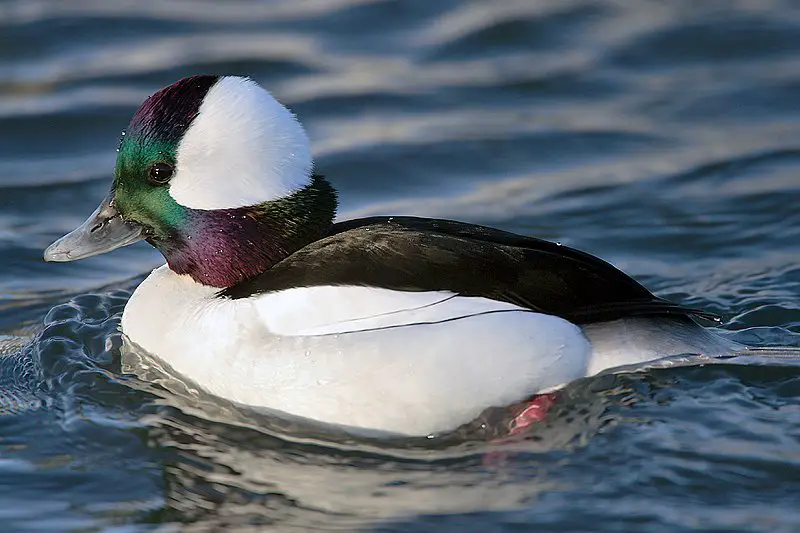
The Bufflehead bird is a small sea duck belonging to the goldeneyes genus. It was first described in 1758 by Carl Linnaeus, and its scientific name is Bucephala albeola.
The name “Bucephala” comes from the Greek words for “bull-headed,” which refers to its oddly shaped, bulbous head.
These birds are known for their striking black and white plumage, with the males sporting distinctive iridescent green and purple feathers on their heads.
Buffleheads are found primarily in North America, spending their winters on coastal waters and migrating inland to breed in wooded areas.
They are skilled divers and feed primarily on insects and small crustaceans. Despite their small size, Buffleheads are hardy birds and can survive in extreme weather conditions.Scientific classification:
| Kingdom | Animalia |
| Phylum | Chordata |
| Class | Aves |
| Order | Anseriformes |
| Family | Anatidae |
| Genus | Bucephala |
| Species | B. albeola |
Also Featured In: Water Birds Live around Us, Estuaries Birds